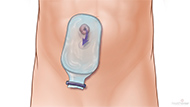Proctocolectomy and Ileostomy for Inflammatory Bowel Disease
Surgery Overview
In proctocolectomy, the large intestine and rectum are removed, leaving the lower end of the small intestine (the ileum). The doctor sews the anus closed and makes a small opening called a stoma in the skin of the lower abdomen. The surgical procedure to create the stoma (or any other artificial opening) is called an ostomy.
The ileum is connected to the stoma, creating an opening to the outside of the body. The surgery that creates the opening to the intestine is called an ileostomy.
Stool empties into a small plastic pouch called an ostomy bag that is applied to the skin around the stoma.
What To Expect
You may stay in the hospital for several days or as long as 2 weeks after surgery, depending on the severity of the inflammatory bowel disease (IBD).
Why It Is Done
Several situations may require surgery for ulcerative colitis or surgery for Crohn's disease, such as when medicines fail to manage your symptoms or when holes develop in the large intestine.
How Well It Works
This surgery cures ulcerative colitis. About 7 to 8 out of 10 people have long-term success with this surgery.footnote 1
Surgery will not cure Crohn's disease. But it may give people some time without symptoms. Crohn's disease usually comes back after surgery.
Risks
The main complications of ileostomy involve infection and problems with the opening to the abdomen (stoma). The following complications may occur:footnote 2
- Up to 30 out of 100 people develop infection.
- Small bowel obstruction occurs in 15 out of 100 people.
- A problem with the stoma develops in up to 30 out of 100 people.
- About 20 to 25 out of 100 people need another surgery to repair the stoma.
What To Think About
It is important to learn how to care for and use your ostomy.
About 1.5 million people in the United States have ostomies.
References
Citations
- Cohen JL, et al. (2005). Practice parameters for the surgical treatment of ulcerative colitis. Diseases of the Colon and Rectum, 48(11): 1997-2009. Available online: http://www.fascrs.org/physicians/practice_parameters.
- Cima RR, Pemberton JH (2010). Ileostomy, colostomy, and pouches. In M Feldman et al., eds., Sleisenger and Fordtran's Gastrointestinal and Liver Disease, 9th ed., vol. 2, pp. 2015-2025. Philadelphia: Saunders Elsevier.
Current as of: March 28, 2018


